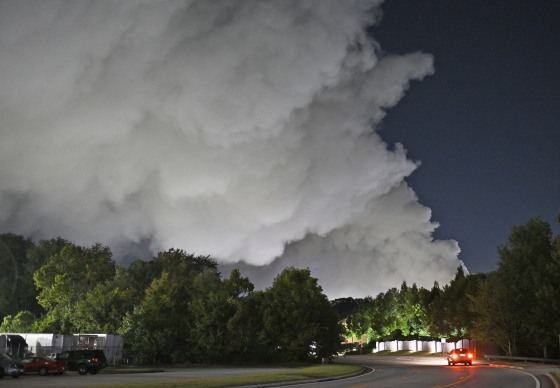
According to the U.S. Chemical Safety Board’s (CSB) September conclusions, a chemical reaction at a Georgia facility caused a hazardous smoke plume and a severe fire that endangered neighboring communities and metropolitan Atlanta.
Following an inquiry into the chemical fire that occurred on September 29 at a BioLab facility in Conyers, Georgia, the board published its conclusions on Friday.
According to the safety board, the primary substances involved were sodium dichloroisocyanurate (DCCA), trichloroisocyanuric acid (TCCA), and bromochloro-5,5-dimethylimidazolidine-2,4-dione (BCDMH), a group of chemicals frequently used for cleaning and disinfection. According to the CSB’s investigation, the chemicals were kept in the plant’s warehouse and produced heat, which ultimately caused them to break down and release poisonous fumes and fires.
According to the CSB, the enormous toxic smoke plumes that resulted had serious off-site effects and contained chlorine and other dangerous materials.
The BioLab facility in Conyers, which produces chlorine-based pool cleaning products under the Clorox brand, is operated by KIK Consumer Products.
A BioLab employee on fire watch reported hearing a bursting sound in one of the warehouses at approximately five in the morning, according to the CSB. Large, dangerous plumes of toxic vapors had eventually leaked into the facility, prompting the employee to dial 911.
According to the CSB, a second, larger fire started just before 12:30 p.m. and was put out at about 4 p.m. By 6:30 a.m., flames were visible above the chemical reaction site and were swiftly put out in less than two hours. That warehouse, called plant 12, was totally destroyed by the fires.
According to the CSB, emergency personnel started leaving the area at that point. Over 90,000 individuals in the metropolitan Atlanta area were instructed to stay put, while about 17,000 residents of the adjacent neighborhood were evacuated. The incident’s final shelter-in-place warning was issued on the evening of October 16 and ended the next day.
According to the CSB, the Environmental Protection Agency monitored the air from September 30 to October 2 and discovered high levels of hydrogen chloride and chlorine. Until October 17, when it found low chlorine levels at 11 monitoring stations near the scene of the incident, the EPA kept up its air monitoring.
The act and the danger it posed to Rockdale County, according to CSB Chairperson Steve Owens, were totally intolerable.
According to a statement from Owens, Bio-Lab and any other facility that has reactive chemicals on site must manage those materials safely because reactive chemical incidents can have serious negative effects on the environment and public safety because of the combination of fire, toxic gas emissions, and hazardous materials involved.
The CSB is still investigating the incident, looking at the reason behind the chemical’s breakdown, how the chemicals were handled and stored, and industry fire safety guidelines for these kinds of compounds.
The board’s final investigative report will include its conclusions and suggestions.
Note: Every piece of content is rigorously reviewed by our team of experienced writers and editors to ensure its accuracy. Our writers use credible sources and adhere to strict fact-checking protocols to verify all claims and data before publication. If an error is identified, we promptly correct it and strive for transparency in all updates, feel free to reach out to us via email. We appreciate your trust and support!
